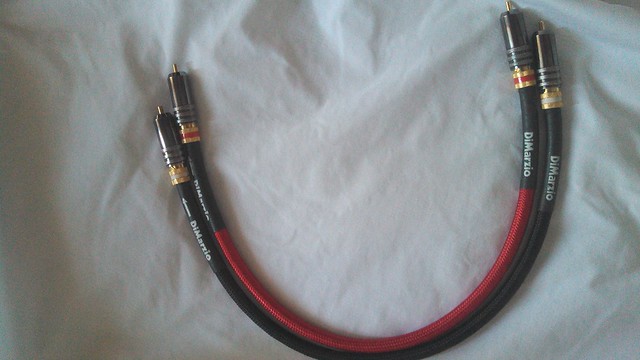This is a mini review for a pair of cables which are produced for studio: they are the High Definition interconnects from Di Marzio.
I decided to buy a short pair after the advice of a friend from Head-Fi, with whom I was discussing my requirements for a reasonably priced pair of RCA cables, sturdy, good sounding, not as fragile as the VH Audio and that wouldn’t mess up the sound by being too blurry or too bright.
They are stranded copper cables (FEP Fluoropolymer-insulated OFHC), made of 240 fine strands of wire in Litz-braid configuration, where the circular cross section of all the wires combined equals to 16 gage. The more strands and the finer the strands the more flexible the wire, which, in this case, I guess is done to insure durability.
They are stiff and very well built, and have very sturdy locking connectors. That’s what I would indeed expect for a pair of cables
They are very transparent sounding and, if I didn’t know, I would have said they were a blend of silver and copper wires. I use them regularly in my ATH-AD2000 headphone system (as of late, mainly with the Metrum and Idat44, both of which are warm/neutral sources). The Di Marzio don’t hide anything, nor they take anything away at the extremes deep bass. They are just very transparent, not as rich as the VH Audio diy silver design, but at the same time, smoother than those.
While there are certain analogue cables, like several Moray James revisions I have been testing until the end of 2011, which markedly alter the tonal balance of a system (either by maximizing resolution/imaging – to the loss of out a bit of body and addition of some sharpness-, or, in an earlier model, pushing the upper bass and the upper midrange, making the sound live and very exciting, but also colouring the system), the Di Marzio manage to become “one less variable” in a system. This quality, makes them a great pair of cables (and affordable), or a reliable starting point, because one can build a system around them by knowing these cables won’t be screwing the overall tonality.
There is something more, though, which can more explicitly explain why they don’t screw-up the sound. Using them, the sound is “solid” and coherent. Such feeling of solidity, which is a necessary brick in realism, isn’t always warranted with all cables.
If needing to do one last step of fine tuning, the cables chen be changed with something else.
There is a superior model (M-Path), on Di Marzio website, which is a bit more expensive and advertised to increase resolution and soundstage, but I don’t know if it will lose some musicality in order to increase those sonic attributes.



